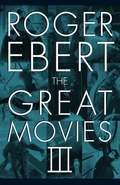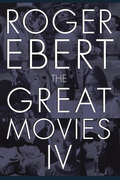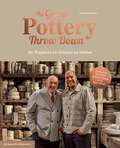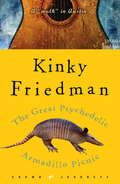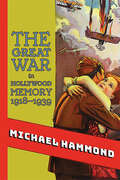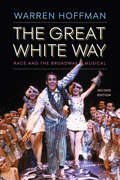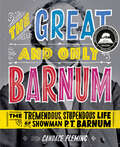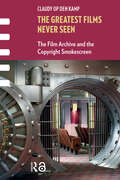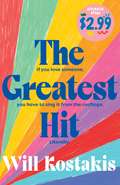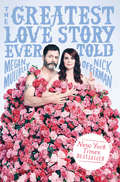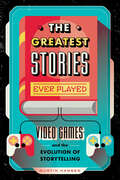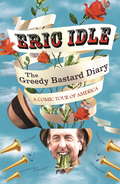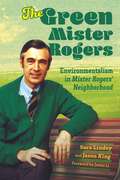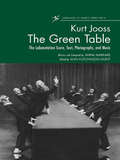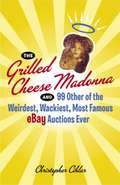- Table View
- List View
The Great Movies
by Roger EbertAmerica's most trusted and best-known film critic Roger Ebert presents one hundred brilliant essays on some of the best movies ever made. For the past five years Roger Ebert, the famed film writer and critic, has been writing biweekly essays for a feature called "The Great Movies," in which he offers a fresh and fervent appreciation of a great film. The Great Movies collects one hundred of these essays, each one of them a gem of critical appreciation and an amalgam of love, analysis, and history that will send readers back to that film with a fresh set of eyes and renewed enthusiasm-or perhaps to an avid first-time viewing. Ebert's selections range widely across genres, periods, and nationalities, and from the highest achievements in film art to justly beloved and wildly successful popular entertainments. Roger Ebert manages in these essays to combine a truly populist appreciation for our most important form of popular art with a scholar's erudition and depth of knowledge and a sure aesthetic sense. Wonderfully enhanced by stills selected by Mary Corliss, film curator at the Museum of Modern Art, The Great Movies is a treasure trove for film lovers of all persuasions, an unrivaled guide for viewers, and a book to return to again and again. The Great Movies includes: All About Eve * Bonnie and Clyde * Casablanca * Citizen Kane * The Godfather * Jaws * La Dolce Vita * Metropolis * On the Waterfront * Psycho * The Seventh Seal * Sweet Smell of Success * Taxi Driver * The Third Man * The Wizard of Oz * and eighty-five more films.From the Hardcover edition.
The Great Movies II
by Roger EbertFrom America's most trusted and highly visible film critic, 100 more brilliant essays on the films that define cinematic greatness.Continuing the pitch-perfect critiques begun in The Great Movies, Roger Ebert's The Great Movies II collects 100 additional essays, each one of them a gem of critical appreciation and an amalgam of love, analysis, and history that will send readers back to films with a fresh set of eyes and renewed enthusiasm--or perhaps to an avid first-time viewing. Neither a snob nor a shill, Ebert manages in these essays to combine a truly populist appreciation for today's most important form of popular art with a scholar's erudition and depth of knowledge and a sure aesthetic sense. Once again wonderfully enhanced by stills selected by Mary Corliss, former film curator at the Museum of Modern Art, The Great Movies II is a treasure trove for film lovers of all persuasions, an unrivaled guide for viewers, and a book to return to again and again.Films featured in The Great Movies II12 Angry Men · The Adventures of Robin Hood · Alien · Amadeus · Amarcord · Annie Hall · Au Hasard, Balthazar · The Bank Dick · Beat the Devil · Being There · The Big Heat · The Birth of a Nation · The Blue Kite · Bob le Flambeur · Breathless · The Bridge on the River Kwai · Bring Me the Head of Alfredo García · Buster Keaton · Children of Paradise · A Christmas Story · The Color Purple · The Conversation · Cries and Whispers · The Discreet Charm of the Bourgeoisie · Don't Look Now · The Earrings of Madame de . . . · The Fall of the House of Usher · The Firemen's Ball · Five Easy Pieces · Goldfinger · The Good, the Bad and the Ugly · Goodfellas · The Gospel According to Matthew · The Grapes of Wrath · Grave of the Fireflies · Great Expectations · House of Games · The Hustler · In Cold Blood · Jaws · Jules and Jim · Kieslowski's Three Colors Trilogy · Kind Hearts and Coronets · King Kong · The Last Laugh · Laura · Leaving Las Vegas · Le Boucher · The Leopard · The Life and Death of Colonel Blimp · The Manchurian Candidate · The Man Who Laughs · Mean Streets · Mon Oncle · Moonstruck · The Music Room · My Dinner with Andre · My Neighbor Totoro · Nights of Cabiria · One Flew Over the Cuckoo's Nest · Orpheus · Paris, Texas · Patton · Picnic at Hanging Rock · Planes, Trains and Automobiles · The Producers · Raiders of the Lost Ark · Raise the Red Lantern · Ran · Rashomon · Rear Window · Rififi · The Right Stuff · Romeo and Juliet · The Rules of the Game · Saturday Night Fever · Say Anything · Scarface · The Searchers · Shane · Snow White and the Seven Dwarfs · Solaris · Strangers on a Train · Stroszek · A Sunday in the Country · Sunrise · A Tale of Winter · The Thin Man · This Is Spinal Tap ·Tokyo Story · Touchez Pas au Grisbi · Touch of Evil · The Treasure of the Sierra Madre · Ugetsu · Umberto D · Unforgiven · Victim · Walkabout · West Side Story · Yankee Doodle Dandy
The Great Movies III
by Roger EbertRoger Ebert has been writing film reviews for the Chicago Sun-Times for over four decades now and his biweekly essays on great movies have been appearing there since 1996. As Ebert noted in the introduction to the first collection of those pieces, “They are not the greatest films of all time, because all lists of great movies are a foolish attempt to codify works which must stand alone. But it’s fair to say: If you want to take a tour of the landmarks of the first century of cinema, start here. Enter The Great Movies III, Ebert’s third collection of essays on the crème de la crème of the silver screen, each one a model of critical appreciation and a blend of love and analysis that will send readers back to the films with a fresh set of eyes and renewed enthusiasm—or maybe even lead to a first-time viewing. From The Godfather: Part II to Groundhog Day, from The Last Picture Show to Last Tango in Paris, the hundred pieces gathered here display a welcome balance between the familiar and the esoteric, spanning Hollywood blockbusters and hidden gems, independent works and foreign language films alike. Each essay draws on Ebert’s vast knowledge of the cinema, its fascinating history, and its breadth of techniques, introducing newcomers to some of the most exceptional movies ever made, while revealing new insights to connoisseurs as well. Named the most powerful pundit in America by Forbes magazine, and a winner of the Pulitzer Prize, Roger Ebert is inarguably the most prominent and influential authority on the cinema today. The Great Movies III is sure to please his many fans and further enhance his reputation as America’s most respected—and trusted—film critic.
The Great Movies IV
by Roger Ebert Matt Zoller Seitz Chaz EbertNo film critic has ever been as influential--or as beloved-- as Roger Ebert. Over more than four decades, he built a reputation writing reviews for the Chicago Sun-Times and, later, arguing onscreen with rival Chicago Tribune critic Gene Siskel and later Richard Roeper about the movies they loved and loathed. But Ebert went well beyond a mere "thumbs up" or "thumbs down." Readers could always sense the man behind the words, a man with interests beyond film and a lifetime's distilled wisdom about the larger world. Although the world lost one of its most important critics far too early, Ebert lives on in the minds of moviegoers today, who continually find themselves debating what he might have thought about a current movie. The Great Movies IV is the fourth--and final--collection of Roger Ebert's essays, comprising sixty-two reviews of films ranging from the silent era to the recent past. From films like The Cabinet of Caligari and Viridiana that have been considered canonical for decades to movies only recently recognized as masterpieces to Superman, The Big Lebowski, and Pink Floyd: The Wall, the pieces gathered here demonstrate the critical acumen seen in Ebert's daily reviews and the more reflective and wide-ranging considerations that the longer format allowed him to offer. Ebert's essays are joined here by an insightful foreword by film critic Matt Zoller Seitz, the current editor-in-chief of the official Roger Ebert website, and a touching introduction by Chaz Ebert. A fitting capstone to a truly remarkable career, The Great Movies IV will introduce newcomers to some of the most exceptional movies ever made, while revealing new insights to connoisseurs as well.
The Great Peace: A Memoir
by Mena SuvariA memoir by award-winning actor Mena Suvari, best-known forher iconic roles in American Beauty, American Pie, and Six Feet Under.The Great Peace is a harrowing, heartbreaking coming-of-age story set in Hollywood, in which young teenage model-turned-actor Mena Suvari lost herself to sex, drugs and bad, often abusive relationships even as blockbuster movies made her famous. It's about growing up in the 90s, with a soundtrack ranging from The Doors to Deee-Lite, fashion from denim to day-glo, and a woman dealing with the lasting psychological scars of abuse, yet knowing deep inside she desires so much more from life.Within these vulnerable pages, Mena not only reveals her own mistakes, but also the lessons she learned and her efforts to understand and grow rather than casting blame. As such, she makes this a timeless story of girl empowerment and redemption, of somebody using their voice to rediscover their past, seek redemption, and to understand their mistakes, and ultimately come to terms with their power as an individual to find a way and a will to live—and thrive. Poignant, intimate, and powerful, this book will resonate with anyone who has found themselves lost in the darkness, thinking there's no way out. Ultimately, Mena's story proves that, no matter how hopeless it may seem, there's always a light at the end.
The Great Pottery Throw Down: 20 Projects to Create at Home
by The Great Pottery ThrowdownThe Great Pottery Throw Down is the official tie-in to the popular Channel 4 show.The Great Pottery Throw Down book is a practical and beautiful guide to creating in clay at home. Accompanying budding potters on their creative journey, this book teaches the basics of both handbuilding and throwing techniques before taking you through 20 projects inspired by the show's challenges. The projects are aimed to build on your skills as you work through them starting with an egg cup or mug and working up to a jug or teapot. Covering a range of topics from setting up your space and choosing the right clay to the basics of using a wheel and the three core hand-building techniques (slab building, coiling and pinching) – this is an essential guide to pottery. The projects include spoon rest, vase, dinner plate, nesting bowls, plant pot, teacup, animal figurine, salad bowl and more. Once you have mastered the basics, finesse your creations with expert tips on decorating, glazing and firing your projects. Discover the joy of the iconic Great Pottery Throw Down in your own home and open yourself up to a world of ceramic possibility.
The Great Psychedelic Armadillo Picnic
by Kinky FriedmanKinky Friedman, the original Texas Jewboy, takes us on a rollicking, rock-and-rolling tour of his favorite city: Austin. Maybe you want to know which restaurant President Bush rates as his favorite Austin burger joint. Or maybe you want a glimpse of Willie Nelson's home life (hint: Willie plays a lot of golf). Perhaps you want to get the best view of the Mexican free-tail bats as they make their nightly flights to and from the Congress Avenue Bridge. Or maybe you're itching to learn the history of a city that birthed Janis Joplin, Stevie Ray Vaughan, and countless other music legends. It's all here in The Great Psychedelic Armadillo Picnic, the slightly insane, amazingly practical, and totally kick-ass guide to the coolest city in Texas by none other than Kinky Friedman. This ain't no ordinary travel guide, neither. "Like most other busy cities these days, Austin is not very effectively traversed by foot," Kinky explains. "You must understand that 'a walk in Austin' is primarily a spiritual sort of thing. " As might be expected from this politically incorrect country-singer-turned-bestselling-mystery-author, the Kinkster's tour includes a bunch of stuff you won't ?nd in a Frommer's guide, from descriptions of Austin's notable trees and directions to skinny-dipping sites to lists of haunted places and quizzes and puzzles. So put on your cowboy hat and your brontosaurus-foreskin boots and head down south with the only book you need to get to the big heart of this great city. From the Hardcover edition.
The Great Radio Heroes
by Jim HarmonReminiscences of the heyday of radio programming, with insights on many of the favorite programs. Contains actor bios and more.
The Great TV Turn-Off (The Cul-De-Sac Kids #18)
by Beverly LewisIt's "TV Turn-Off Week" across America, and Eric Hagel proposes that the kids on Blossom Hill Lane--adults, too!--don't watch a speck of TV for seven days. But midway through the week, Eric catches Mr. Tressler sneaking a peek at his TV. What will they do now?
The Great War in American and British Cinema, 1918–1938: Art Amidst the Ashes (Palgrave Studies in the History of the Media)
by Ryan CoppingThis book recounts the reception of selected films about the Great War released between 1918 and 1938 in the USA and Great Britain. It discusses the role that popular cinema played in forming and reflecting public opinion about the War and its political and cultural aftermath in both countries. Although the centenary has produced a wide number of studies on the memorialisation of the Great War in Britain and to a lesser degree the USA, none of them focused on audience reception in relation to the Anglo-American ‘circulatory system’ of Trans-Atlantic culture.
The Great War in Hollywood Memory, 1918-1939 (SUNY series, Horizons of Cinema)
by Michael HammondThis is the definitive account of how America's film industry remembered and reimagined World War I from the Armistice in 1918 to the outbreak of World War II in 1939. Based on detailed archival research, Michael Hammond shows how the war and the sociocultural changes it brought made their way into cinematic stories and images. He traces the development of the war's memory in films dealing with combat on the ground and in the air, the role of women behind the lines, returning veterans, and through the social problem and horror genres. Hammond first examines movies that dealt directly with the war and the men and women who experienced it. He then turns to the consequences of the war as they played out across a range of films, some only tangentially related to the conflict itself. Hammond finds that the Great War acted as a storehouse of motifs and tropes drawn upon in the service of an industry actively seeking to deliver clearly told, entertaining stories to paying audiences. Films analyzed include The Big Parade, Grand Hotel, Hell's Angels, The Black Cat, and Wings. Drawing on production records, set designs, personal accounts, and the advertising and reception of key films, the book offers unique insight into a cinematic remembering that was a product of the studio system as it emerged as a global entertainment industry.
The Great White Way: Race and the Broadway Musical
by Warren HoffmanBroadway musicals are one of America’s most beloved art forms and play to millions of people each year. But what do these shows, which are often thought to be just frothy entertainment, really have to say about our country and who we are as a nation? Now in a new second edition, The Great White Way is the first book to reveal the racial politics, content, and subtexts that have haunted musicals for almost one hundred years from Show Boat (1927) to Hamilton (2015). This revised edition includes a new introduction and conclusion, updated chapters, as well as a brand-new chapter that looks at the blockbuster musicals The Book of Mormon and Hamilton. Musicals mirror their time periods and reflect the political and social issues of their day. Warren Hoffman investigates the thematic content of the Broadway musical and considers how musicals work on a structural level, allowing them to simultaneously present and hide their racial agendas in plain view of their audiences. While the musical is informed by the cultural contributions of African Americans and Jewish immigrants, Hoffman argues that ultimately the history of the American musical is the history of white identity in the United States. Presented chronologically, The Great White Way shows how perceptions of race altered over time and how musicals dealt with those changes. Hoffman focuses first on shows leading up to and comprising the Golden Age of Broadway (1927–1960s), then turns his attention to the revivals and nostalgic vehicles that defined the final quarter of the twentieth century. He offers entirely new and surprising takes on shows from the American musical canon—Show Boat (1927), Oklahoma! (1943), Annie Get Your Gun (1946), The Music Man (1957), West Side Story (1957), A Chorus Line (1975), and 42nd Street (1980), among others. In addition to a new chapter on Hamilton and The Book of Mormon, this revised edition brings The Great White Way fully into the twenty-first century with an examination of jukebox musicals and the role of off-Broadway and regional theaters in the development of the American musical. New archival research on the creators who produced and wrote these shows, including Leonard Bernstein, Jerome Robbins, Stephen Sondheim, and Edward Kleban, will have theater fans and scholars rethinking forever how they view this popular American entertainment.
The Great and Only Barnum: The Tremendous, Stupendous Life of Showman P. T. Barnum
by Candace FlemingThe life of showman Phineas Taylor Barnum gets show-stopping treatment in Fleming's latest biographical work. Presented as clever, resilient and ever-consumed with making a buck, the Barnum of the Ringling Bros. and Barnum & Bailey Circus is brought to life in anecdotes over 11 chapters. Nicknamed Tale as a boy, he hated farmwork (I was always ready to concoct fun, or lay plans for money-making, but hand-work was decidedly not in my line). His personal struggles with alcohol and a less-than-happy marriage are detailed alongside his many public successes (and hoaxes). A tour of his famed American Museum and an account of a day at the circus (complete with descriptions of the human curiosities Barnum employed) set readers in the middle of the singular late 19th-century entertainment scene. As in a real circus, the large-format pages include plenty to grab readers' attention: white-on-black sidebars that put the entrepreneur's feats in context (African Americans were barred from entering Barnum's American Museum except on certain days), bw photos and advertising posters. Audiences will step right up to this illuminating and thorough portrait of an entertainment legend. Ages 8-12. Copyright Reed Business Information, a division of Reed Elsevier Inc. All rights reserved.
The Great and Only Barnum: The Tremendous, Stupendous Life of Showman P. T. Barnum
by Candace FlemingDiscover the true story of P.T. Barnum, the man who created the world-famous Barnum & Bailey Circus, as featured in the movie The Greatest Showman! The award-winning author of The Lincolns: A Scrapbook Look at Abraham and Mary, Amelia Lost, and Our Eleanor brings us the larger-than-life biography of showman P. T. Barnum. Known far and wide for his jumbo elephants, midgets, and three-ring circuses, here&’ s a complete and captivating look at the man behind the Greatest Show on Earth. Readers can visit Barnum&’s American Museum; meet Tom Thumb, the miniature man (only 39 inches tall) and his tinier bride (32 inches); experience the thrill Barnum must have felt when, at age 60, he joined the circus; and discover Barnum&’s legacy to the 19th century and beyond. Drawing on old circus posters, photographs, etchings, ticket stubs—and with incredible decorative art by Ray Fenwick—this book presents history as it&’s never been experienced before—a show-stopping event!
The Greatest Films Never Seen: The Film Archive and the Copyright Smokescreen (Framing Film)
by Claudy Op den KampOrphan works, or artworks for which no copyright holder is traceable, pose a growing problem for museums, archives, and other heritage institutions. As they come under more and more pressure to digitize and share their archives, they are often hampered by the uncertain rights status of items in their collections. The Greatest Films Never Seen: The Film Archive and the Copyright Smokescreen uses the prism of copyright to reconsider human agency and the politics of the archive, and asks what the practical implications are for educational institutions, the creative industries, and the general public.
The Greatest Hit: Australia Reads Special Edition
by Will KostakisPeople look at Tessa and see her biggest mistake.While everyone else her age is taking their bold first steps into adulthood, she's just trying to outrun a song that went viral when she was fourteen.But now - an opportunity. A profile as one of The Five Most Forgettable Internet Celebrities of the Decade So Far gives her the chance to right a wrong, and the courage to sing her greatest hit as it was originally written. But will it be enough to win back the person she hurt?A touching new story from one of Australia's leading YA writers.
The Greatest Love Story Ever Told: An Oral History
by Nick Offerman Megan MullallyMegan Mullally and Nick Offerman reveal the full story behind their epic romance--presented in a series of intimate conversations between the couple, including photos, anecdotes, and the occasional puzzle. <P><P>The year: 2000. The setting: Los Angeles. A gorgeous virtuoso of an actress agreed to star in a random play, and a basement-dwelling scenic carpenter said he would assay a supporting role in the selfsame pageant. At the first rehearsal she surveyed her fellow cast members, determining if any of the men might qualify to provide her with a satisfying fling. Her gaze fell upon the carpenter, and like a bolt of lightning the thought struck her: no dice. Moving on.Yet, unbeknownst to our protagonists, Cupid had merely set down his bow and picked up a rocket launcher . . . that fired a love rocket (not a euphemism). <P><P>The players were Megan Mullally and Nick Offerman, and the resulting romance, once ignited, was . . . epic. Beyond epic. It resulted in a coupling that has endured to this day; a sizzling, perpetual tryst that has captivated the world with its kindness, athleticism, astonishingly low-brow humor, and true (fire emoji) passion. <P><P>How did they do it? <P><P>They came from completely different families, ignored a significant age difference, and were separated by the gulf of several social strata. Megan loved books and art history; Nick loved hammers. But much more than these seemingly unsurpassable obstacles were the values they held in common: respect, decency, the ability to mention genitalia in almost any context, and an abiding obsession with the songs of Tom Waits. <P><P>Eighteen years later, they're still very much in love and have finally decided to reveal the philosophical mountains they have conquered, the lessons they've learned, and the myriad jigsaw puzzles they've completed. Presented as an oral history in a series of conversations between the couple, the book features anecdotes, hijinks, photos, and a veritable grab bag of tomfoolery. This is not only the intoxicating book that Mullally's and Offerman's fans have been waiting for, it might just hold the solution to the greatest threat facing our modern world: the single life. <P><b>A New York Times Bestseller</b>
The Greatest Stories Ever Played: Video Games and the Evolution of Storytelling (Game On #2)
by Dustin HansenIn this fun and informative YA Non-fiction title, Dustin Hansen, author of Game On!, a self-confessed video game addict with over 20-years experience in the gaming industry, examines the storytelling skills shown in some of the most beloved and moving games of all time.We all know that video games are fun, but can a video game make you cry? Can it tell you a powerful love story? Can a video game make you think differently about war? About the environment? About the choices you make?Whether it's playing through blockbuster-esque adventures (Uncharted, God of War, The Last of Us), diving deep into hidden bits of story and lore (Red Dead Redemption II, Bioshock, Journey) or building relationships that change the fate of the world itself (Persona 5, Undertale), video games are bringing stories to life in ways that are immediate, interactive and immersive. Focusing on some of the best, most memorable, experiences in gaming, The Greatest Stories Ever Played, examines the relationship between gaming and storytelling in a new way.
The Greatest Westerns Ever Made and the People Who Made Them
by Henry C. Parke True West MagazineThe Greatest Westerns Ever Made and the People Who Made Them provides an eclectic review of the Western film and television genre, from John Ford&’s classic, black and white films, to Deadwood and indie darlings. Screenwriter Henry C. Parke presents a nuanced look at Hollywood&’s dramatization of historic events, the common themes and archetypes of Western movies, and the characters we love (and sometimes love to hate). This book also features essays and interviews with influential Western filmmakers, character actors, the women of Western films (in front of and behind the cameras), and the Native American perspective on Western films and Hollywood&’s portrayal of Native American people.
The Greedy Bastard Diary: A Comic Tour of America
by Eric IdleEric Idle, the legendary star of Monty Python fame, takes fans on a deeply personal and hilarious whirlwind tour around America.'I still feel somewhat nervous encroaching on the Palin territory of writing a travel diary based on a journey ... though it is true, I reason, that all the Pythons have been involved in documentaries. So this must be a Python thing. What is this urge to probe and examine by ex-comedians? Are they tired of dressing up as women? Surely not.' - Eric IdleThe man who brought you the anthems 'Always Look on the Bright Side of Life' and 'Sit on my Face' shows his naughty bits - and much more! As he crossed the US on The Greedy Bastard Tour, Eric Idle kept a diary on the Monty Python website updating fans with his experiences, insights and observations. Inspired by those blogs, THE GREEDY BASTARD DIARY is an honest, hysterical and moving book - part travelogue, part memoir - that chronicles those 80 days on the road, offering Idle's thoughts on his career, personal life and the country he now calls his home. Reflective, ironic, and stamped with his renowned wit, this illuminating work takes readers on a personal tour with the legendary star and offers an intimate, close-up look inside the man as never before.
The Green Mister Rogers: Environmentalism in Mister Rogers' Neighborhood (Children's Literature Association Series)
by Jason King Sara LindeyFred Rogers was an international celebrity. He was a pioneer in children’s television, an advocate for families, and a multimedia artist and performer. He wrote the television scripts and music, performed puppetry, sang, hosted, and directed Mister Rogers’ Neighborhood for more than thirty years. In his almost nine hundred episodes, Rogers pursued dramatic topics: divorce, death, war, sibling rivalry, disabilities, racism. Rogers’ direct, slow, gentle, and empathic approach is supported by his superior emotional strength, his intellectual and creative courage, and his joyful spiritual confidence. The Green Mister Rogers: Environmentalism in “Mister Rogers’ Neighborhood” centers on the show’s environmentalism, primarily expressed through his themed week “Caring for the Environment,” produced in 1990 in coordination with the twentieth anniversary of Earth Day. Unfolding against a trash catastrophe in the Neighborhood of Make-Believe, Rogers advances an environmentalism for children that secures children in their family homes while extending their perspective to faraway places, from the local recycling center to Florida’s coral reef. Rogers depicts animal wisdom and uses puppets to voice anxiety and hope and shows an interconnected world where each part of creation is valued, and love is circulated in networks of care. Ultimately, Rogers cultivates a practical wisdom that provides a way for children to confront the environmental crisis through action and hope and, in doing so, develop into adults who possess greater care for the environment and a capacious imagination for solving the ecological problems we face.
The Green Screen Handbook: Real-World Production Techniques
by Jeff FosterThe Green Screen Handbook, Second Edition is a comprehensive how-to manual that walks you through the many integral techniques required in preproduction, production, and postproduction to use green screen effectively. Step-by-step instruction and time-saving tips cover matting and keying basics; lighting and digital camera essentials; setups using fabric, portable background panels, and paint; broadcast TV hardware switchers; professional HD and major motion picture compositing; multi-colored screen composites; directing storyboards and talent; working with virtual sets; motion tracking; and much more. Additionally, this new edition has been updated to include: Coverage of the latest digital camera technologies, lighting gear, and compositing and editing software Advice on using apps for portable devices that will help you light and shoot better green screen Examples and case studies of real-world green screen and compositing projects in film and television productions An extensive companion website (www.focalpress.com/cw/foster) featuring downloadadble project files and streaming video tutorials You can’t afford to miss out! The Green Screen Handbook, Second Edition is a one-stop shop for all of your green screen solutions.
The Green Table: The Labanotation Score, Text, Photographs, and Music
by Ann Hutchinson Guest* Score, photographs, and production details of one of this century's best-loved ballets * Includes rare archival material * Packaged with audio CD This work brings together the complete dance score of The Green Table--one of the most famous ballets of the 20th century--in Labanotation, along with music notation for the piano accompaniment and a complete recording of the accompaniment on CD. It also includes several essays about the work and its genesis, and many historic production photographs. This book is an important item for all colleges with dance programs to own in their libraries and for scholars interested in the study of contemporary dance.
The Grilled Cheese Madonna and 99 Other of the Weirdest, Wackiest, Most Famous eBay Auctions Ever
by Christopher CihlarFor sale: The state of West Virginia Britney Spears's Pregnancy Test A Spare Kidney Bob Dylan's Childhood Home The World's Longest French Fry Black Betsy The Meaning of Life There is only one place you can get all of these under one roof. In addition to being one of the world's largest retailers, eBay is also home of some of the most notorious, creative, and just plain weird items to ever hit the virtual auction block. This comic celebration of the spirit of free enterprise brings together the full stories of one hundred of the most hilarious eBay auctions ever. From the "Ghost in a Jar" auction that recorded more than a million page views, to the woman who auctioned off her virginity before eBay shut her page down, to the saintly grilled cheese sandwich said to portray the face of the Virgin Mary and contain special powers, to the man who modeled his ex-wife's wedding dress, sold it for more than three times its original purchase price, and received several marriage proposals to boot, this book chronicles the listings that have made the site such an integral--and entertaining--part of our culture. The Grilled Cheese Madonnais a salute to capitalism in its most ridiculous form.
The Grip Book
by Michael G. UvaGain the essential skills of a professional grip to become the jack and master of all trades on a movie or television show set. Discover vital insider tips ranging from how to operate cutting-edge rigging and lighting equipment to performing difficult camera mounts on aircraft, boats, cars, and trains. In The Grip Book, Fifth Edition, seasoned Hollywood grip Michael G. Uva teaches you to install, set up, maintain, and ensure the safety of all equipment on a set, such as C-stands, cameras, and any specialty gear needed for a shoot. Guidelines for on-set etiquette and how to succeed as a technical crew member will jumpstart your career and make you a valuable asset on any film or television crew. This newly enhanced edition marks the 25th anniversary of a Focal Press classic and has been updated to include: A 4-color insert covering greenscreen setup Technical expertise on maintaining the latest and greatest filmmaking equipment Engaging how-to videos on the companion website (www.focalpress.com/9780415842372) which demonstrate techniques described in the book A completely new test section with over one hundred questions and answers, allowing you to quiz yourself on the techniques and concepts you've just read Guidelines on what a grip has to be physically able to perform in their day-to-day duties A European-specific appendix that features a table of European grip terms and their American equivalents Whether you are a professional grip looking to boost your skills or an aspiring one just beginning to learn the trade, the time-tested tips and techniques for smooth and safe operation on set make this new edition an indispensable reference guide.


